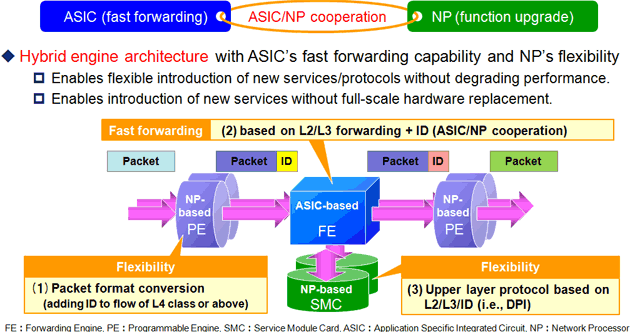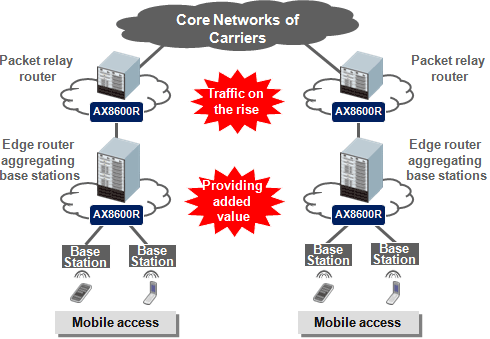In the current carrier backbone networks, handling increasing traffic is a serious challenge facing network operations. In addition, providing a value-added service as an advantage over others is an important business issue. To achieve these goals, devices used in carrier backbone network must have both high functionality for handling increasing traffic and flexibility for providing various kinds of services. The ALAXALA AX series provides a network infrastructure that addresses these issues. This section introduces a mobile network as an example of a carrier backbone network.
Challenges facing carrier backbone networks
- Providing various services while handling increasing traffic
- Optimization of investment efficiency for future bandwidth upgrade
High-performance hybrid engine architecture (#)
In mobile networks, various kinds of services (e.g., voice transmission, data transmission, mobile virtual network operators) are provided via a tunnel established between a base station accommodating mobile terminals and a backbone network. Therefore, packet forwarding devices in networks must be capable of tunnel session management, fast packet forwarding via tunnels, flexible linkage between a tunnel and QoS / DPI, etc.
The AX8600R series employs hybrid engine architecture, which can achieve high-performance, high-flexibility packet forwarding with cooperative operations between ASIC (Application Specific Integrated Circuit) and NP (Network Processor). The AX8600R series performs packet format conversion / labeling for tunneling with its programmable engine (PE) serving as NP on a line card, and performs the basic forwarding functions of routers (e.g., packet relay, QoS, filtering) at a fast rate with its forwarding engine (FE) according to a label (ASIC-NP cooperative function). Further, by specifying the NP of a service module card (SMC) as a packet forwarding destination, it becomes possible to provide upper-layer optional functions (e.g., security, accounting) using the NP.
The merits of the hybrid engine architecture are not limited to fast routing and flexibility. Compared to a conventional networking method using appliances (DPI / VPN Tunnel) and routers, the hybrid engine architecture is better at reducing CAPEX / OPEX / power consumption because it can eliminate performance bottlenecks and reduce the number of appliances / physical lines by implementing functions on an NP directly connected to the internal path of a router.

Using the AX8600R in a terabit-class fast network
In mobile networks, traffic is increasing at a very fast rate, due to which terabit- class networks (e.g., networks using 100G Ethernet) are expected to be used as core networks.
The AX8600R series supports not only 100G Ethernet but also 400G / 1T Ethernet (available just by replacing a module). This extends the operating cycle of the device even if traffic increases at a fast rate.
(#) To be supported in future.
Network configuration image

Routers
- AX8600R Series
-
100 Gigabit Ethernet high-end routers playing leading roles in networking strategies
(Hybrid engine architecture, 100 Gigabit Ethernet)



